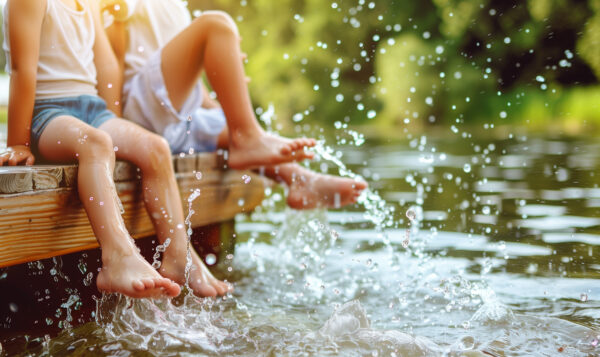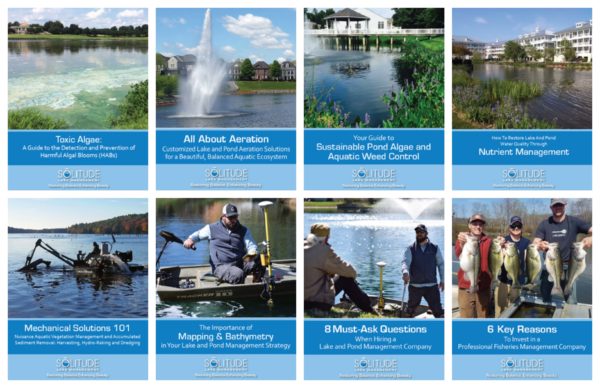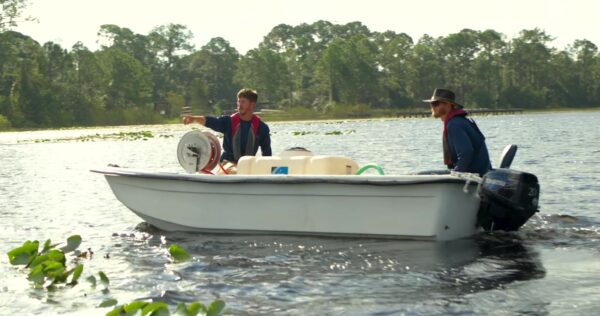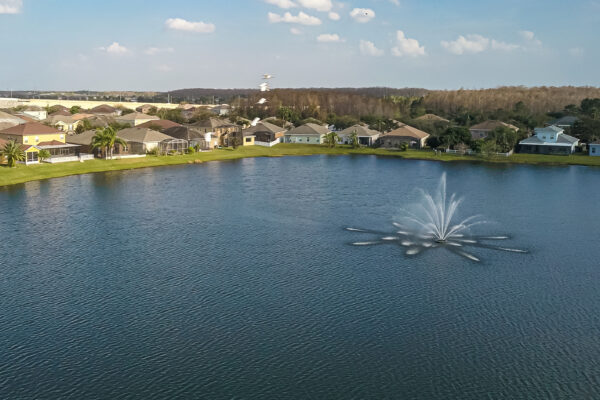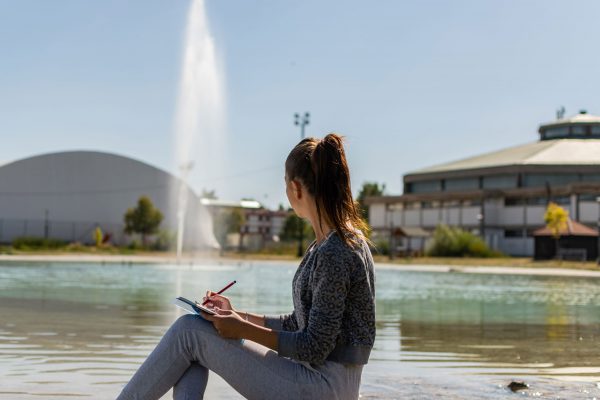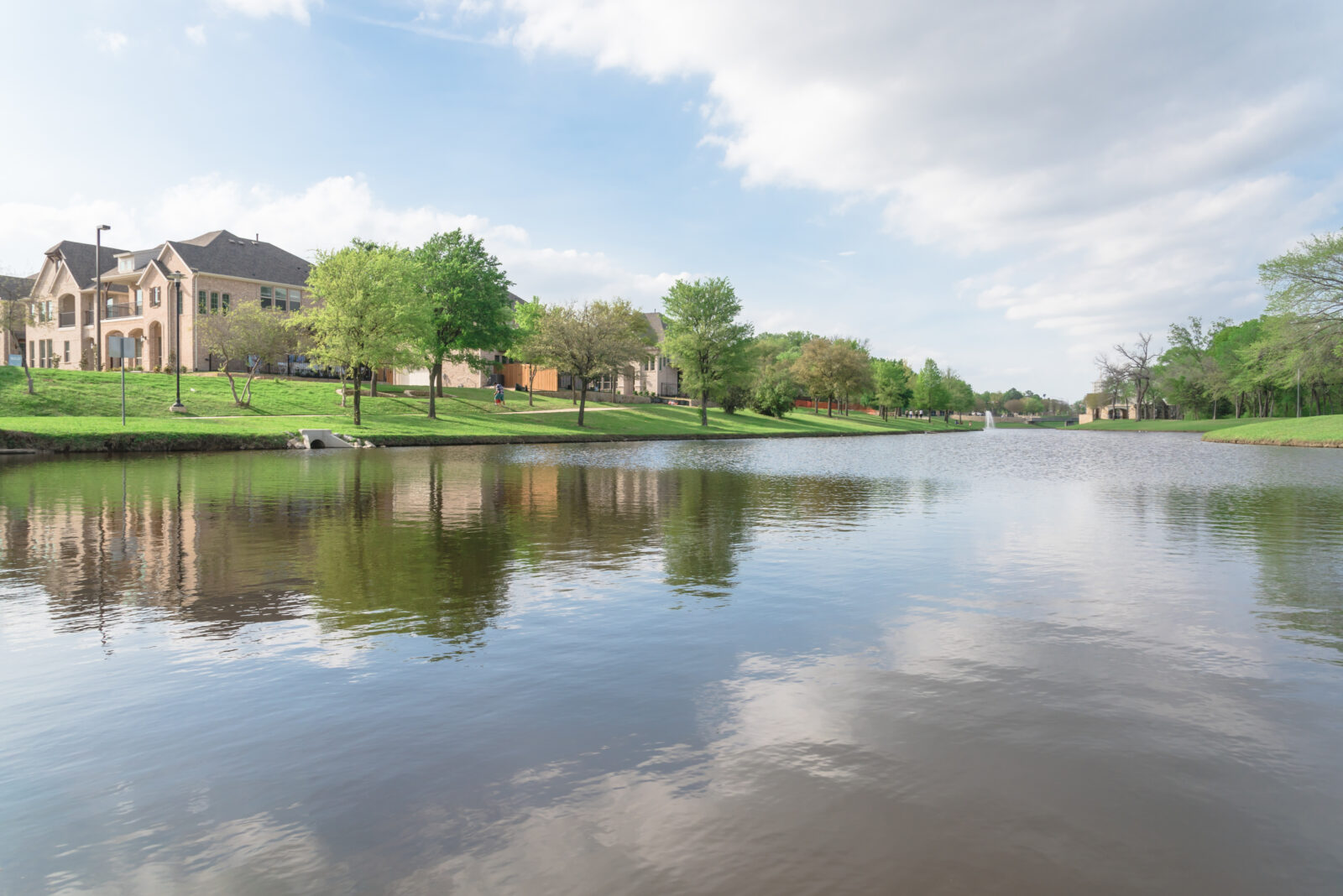
Why Stormwater Pond Maintenance Matters More Than You Think
Stormwater ponds, also known as retention ponds or detention ponds, play a critical role in our residential communities, golf courses, and other urban spaces. While they may appear simple on the surface, they depend on a variety of systems and components to function properly. From fountains and aerators to erosion control measures and carefully managed depth and volume, many elements work together behind the scenes to maintain water quality, safety, and performance.
That’s why proactive inspections, maintenance, and smart budgeting are so important. When you plan ahead, you can spot issues early, avoid surprise expenses, and replace critical components before they cause long-term damage.
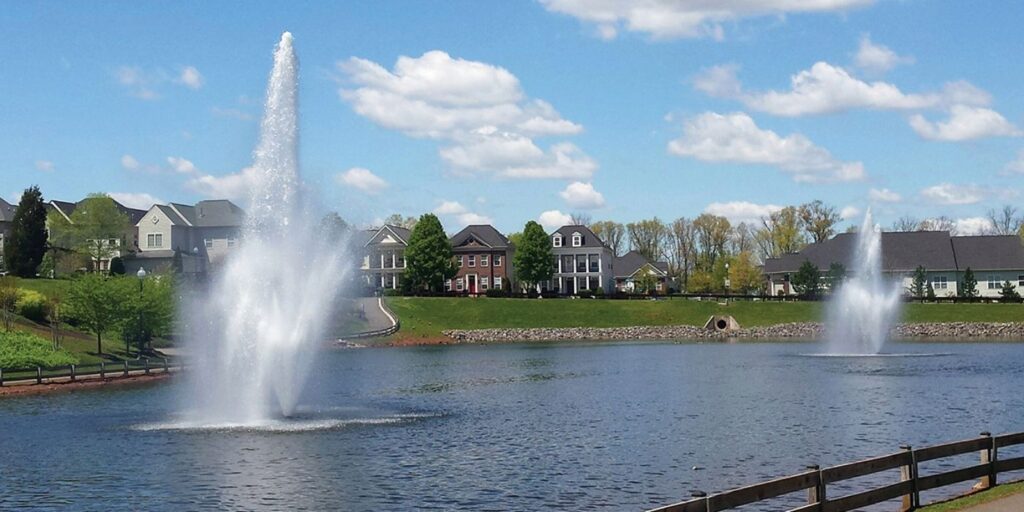
Pond Fountains and Aeration Systems
Pond fountains and pond aerators are essential for maintaining healthy stormwater ponds. They help circulate oxygen throughout the water column, prevent stagnation, and promote conditions that are less conducive to algae and nuisance weeds.
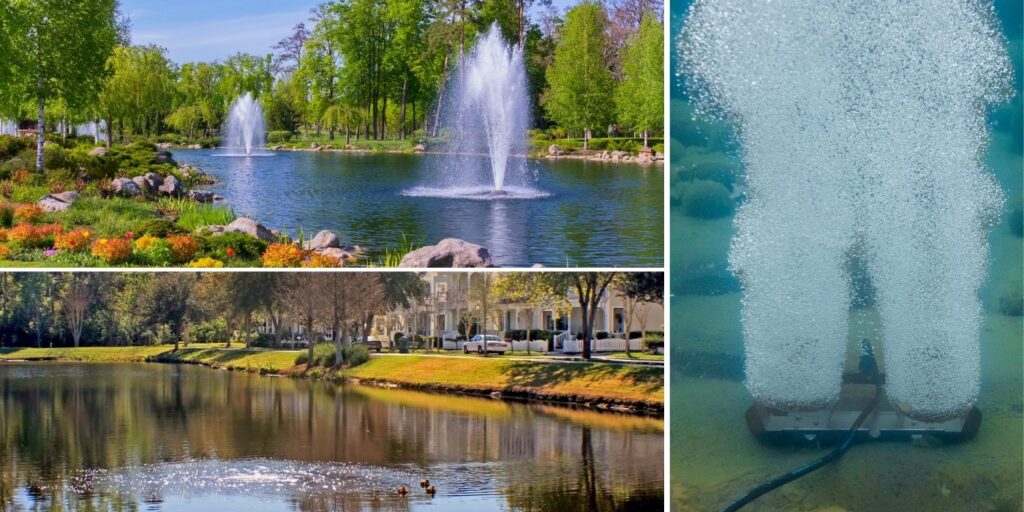
Types of Pond Fountains and Aeration Systems
- Floating fountains – Circulate waterbodies 4-6 feet deep and may incorporate unique spray patterns and lights to enhance aesthetic appeal.
- Surface aerators – Churn water in ponds 4-8 feet deep, delivering 10x the oxygenation benefits of traditional fountains.
- Submersed aerators – Ideal for waterbodies over 6 feet deep, they pump air to the bottom through bottom diffusers. As air bubbles rise, they help circulate and oxygenate the water column.
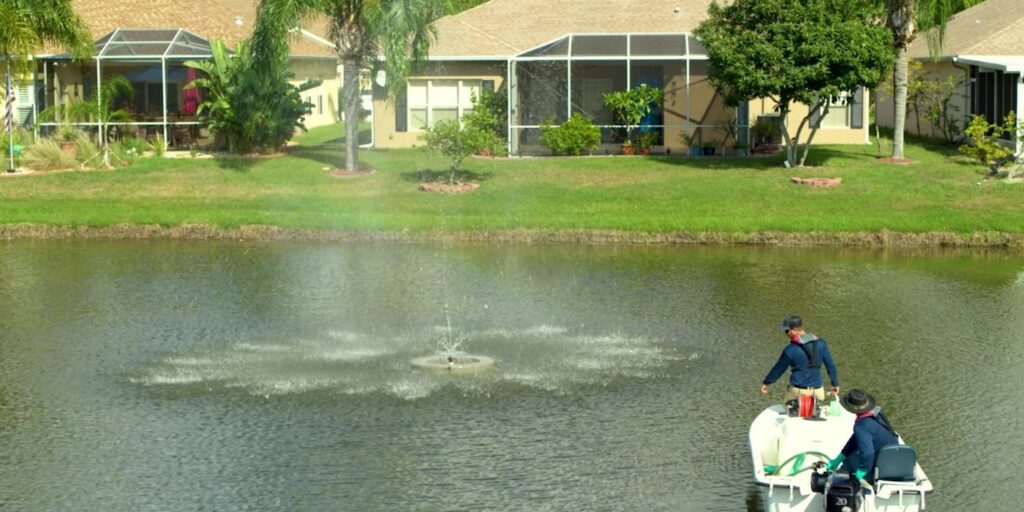
How to Know When It’s Time to Replace a Fountain or Aeration System
Most pond fountains and aeration systems need to be replaced every 5-10 years. If your pond aeration system is underperforming, it may be time to consider replacement. Key indicators include:
- Frequent breakdowns – Constant outages or poor water circulation can signal aging components. Submersed systems, in particular, lose air pressure over time and need regular service
- Mounting repair costs – Repeated “band-aid” fixes can quickly exceed the cost of a new system. Replacing one part on an older unit often leads to failure elsewhere, increasing water quality issues and management costs.
- Outdated equipment – Systems near the end of their 5–10 year lifespan are more prone to inefficiency and higher energy use. Older models may also lack updated components that improve performance and longevity.
Investing in a replacement can prevent future headaches and help maintain a healthy, balanced waterbody. New units are typically more energy-efficient and include 2–5 year full warranties.
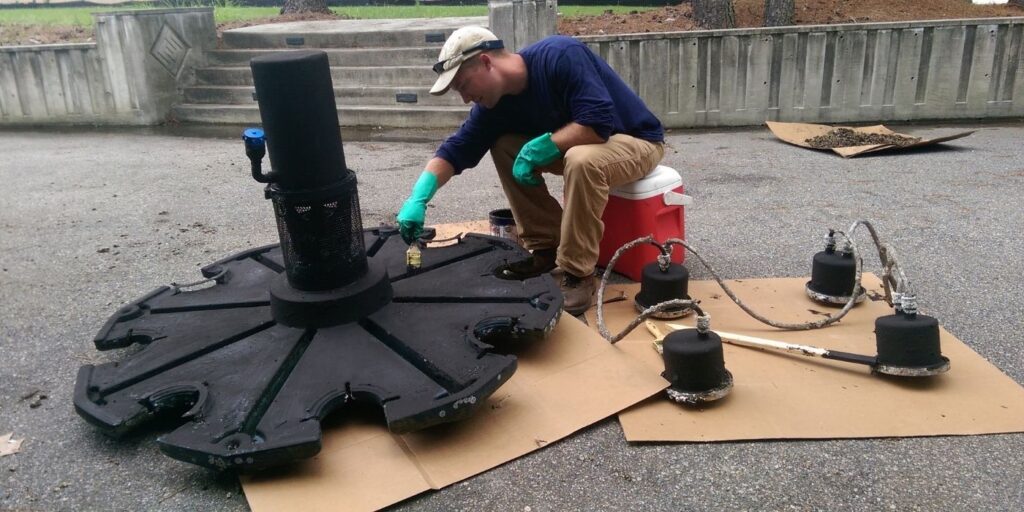
How to Prolong the Lifespan of Your Pond Fountain or Aerator
- Perform regular maintenance – Schedule routine servicing that includes changing oils and seals, checking for worn parts, and removing debris from intakes or nozzles.
- Prevent freeze damage – In colder climates, remove fountains and pond aerators before winter to avoid freeze-related cracking or motor damage. Store equipment indoors and follow manufacturer guidelines for off-season care.
- Protect electrical components – Ensure that all connections are waterproof and that control panels are protected from nuisance animals to prevent dangerous electrical issues.
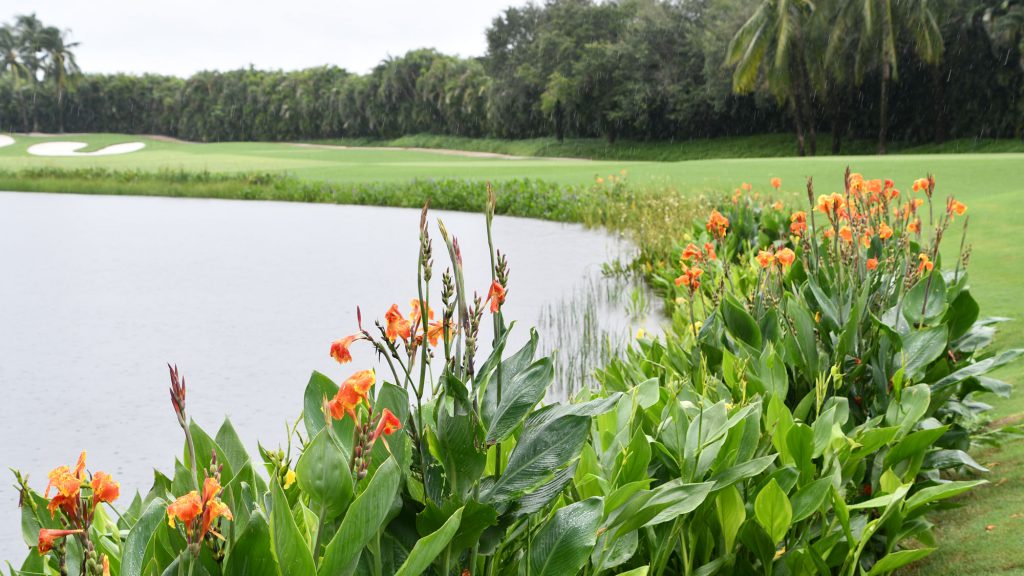
Pond Shoreline Restoration
Shoreline management is just as important as water quality management. Over the years, rain, wind, wildlife activity, and other natural factors can cause wear and tear around the perimeter of waterbodies. Human activities such as landscaping and recreation can exacerbate shoreline deterioration.
Eroded, unstable shorelines pose safety risks, reduce the square footage of waterfront properties, and may cause home values to decline. Not to mention, unstable banks can impede a stormwater pond’s functionality, increasing the risk of flooding. Stakeholders should prepare for the eventual shoreline restoration needs to ensure the necessary funds are in place when the time comes.
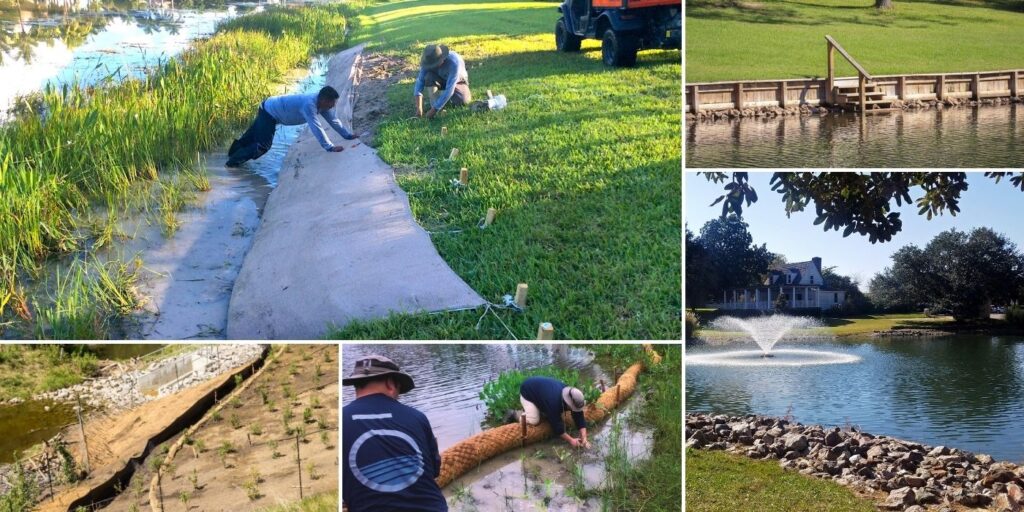
Types of Shoreline Restoration Solutions
Every shoreline restoration project is unique, so experts can utilize several systems depending on the level of deterioration, budget, and desired results.
- Bioengineering – A patented mesh material is packed with sediment or organic matter, contoured to the desired slope, and secured to the stable portion of the shoreline.
- Riprap – Riprap consists of large rocks or stones placed along the shoreline to absorb wave energy and help prevent soil erosion.
- Erosion control logs – These cylindrical logs reduce the force of wave action on the shoreline. Vegetation can be planted directly into them for a more natural, integrated look.
- Silt fences – Silt fences are porous barriers that let water flow through while capturing sediment, helping to stop it from eroding into the pond or lake.
- Bulkheads – A bulkhead is a structural barrier made of wood, concrete, or steel that shields the shoreline from wave action to prevent erosion.
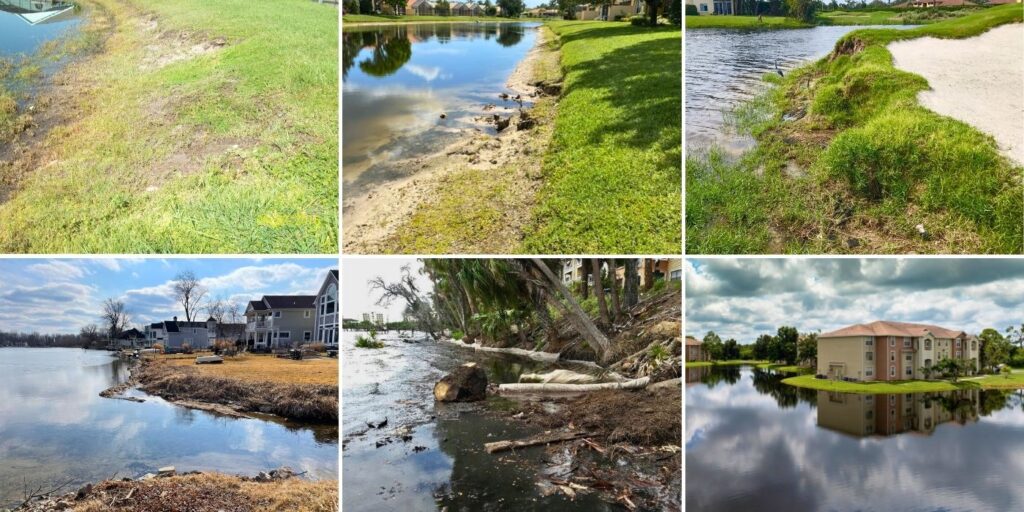
How to Know When It’s Time For Shoreline Restoration
Shoreline erosion can come in many forms that may not be immediately recognizable. That’s why it’s important to regularly monitor for early signs of deterioration.
- Unnatural contours – Visible erosion like deep ruts, steep drop-offs, and a receding shoreline or loss of land is easy to spot, but early signs include irregular shorelines or small peninsulas. The appearance of plant-covered islands may also signal uneven sediment loss or buildup.
- Bare earth – Erosion can impact your shoreline beyond creating unstable banks. Bare earth or vegetation loss along your pond’s bank is another indicator of erosion damage.
- Flooding – As eroded sediment gets washed into the waterbody, it will lose its capacity to hold water. These changes may go unnoticed until dangerous flooding occurs during a heavy rainstorm.
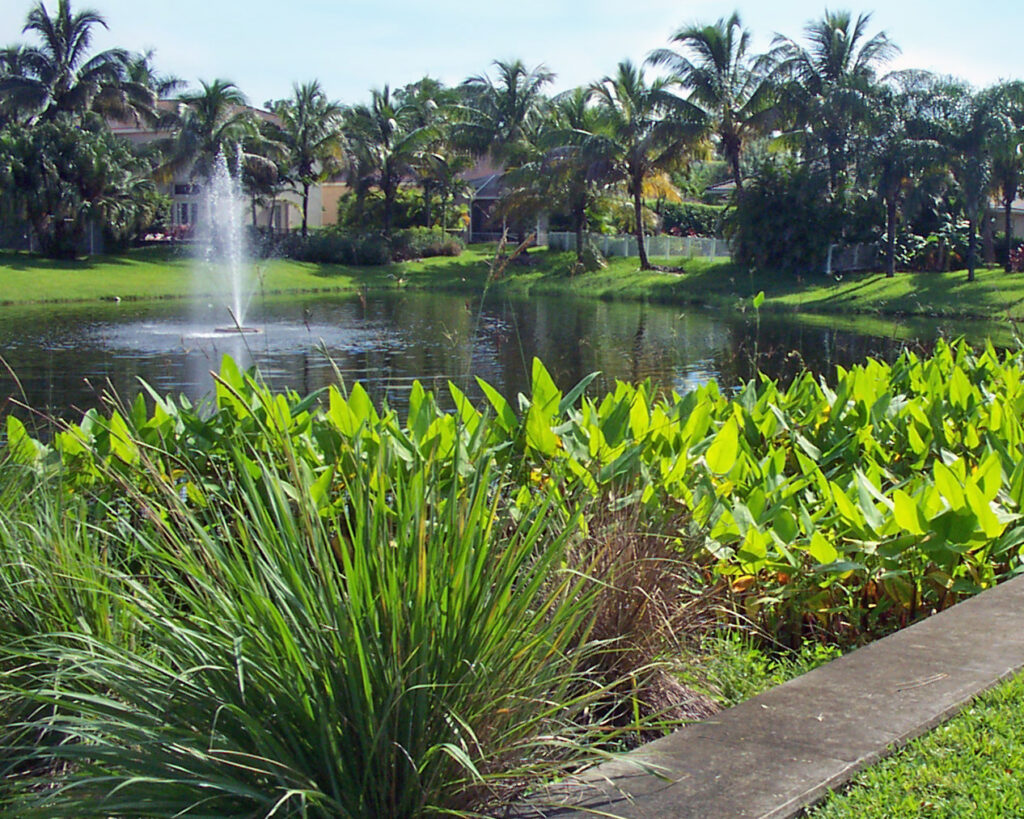
How to Prolong the Integrity of Your Pond Shoreline
- Plant beneficial buffers – Establish native grasses, shrubs, and emergent plants along the shoreline to stabilize soil and slow the impact of stormwater runoff when it rains.
- Establish walking paths – Foot traffic can disturb soil and trample shoreline vegetation. Creating gravel or mulched paths helps guide people away from sensitive areas, prevent falls, and limit long-term wear.
- Adopt responsible landscaping practices – Avoid mowing beneficial buffers, making them too narrow. A proper shoreline buffer should be 3 to 5 feet wide along the pond’s perimeter.
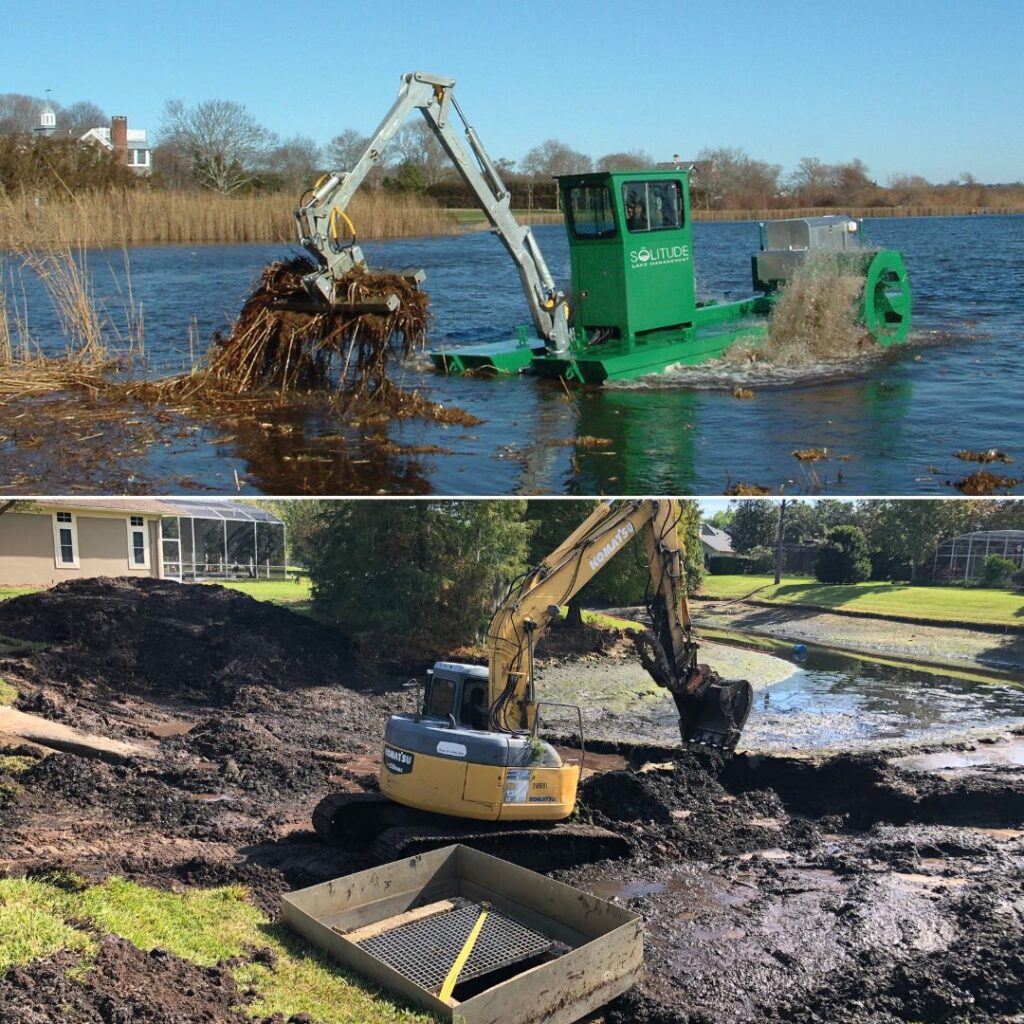
Pond Muck Removal and Management
Stormwater ponds naturally accumulate sediment, which gradually reduces their depth and water-holding capacity, and increases the risk of dangerous flooding and infrastructure damage during rainstorms. Without intervention, a pond will eventually fill until it’s simply a puddle. Stakeholders can choose from several muck removal solutions, depending on factors like budget and environmental restrictions.
Types of muck management solutions
- Mechanical dredging – Mechanical dredges use buckets to excavate muck and sediment. Plant debris and rooted materials can also be removed as part of this process.
- Hydraulic dredging – Hydraulic dredging uses a submersible pump to remove sediment and debris, which is transported through a pipeline to the surface.
- TryMarine – TryMarine focuses on increasing oxygen levels in the bottom muck, helping to process the nutrient-rich muck into usable nutrients that are then consumed by the lake’s natural food web. This, in turn, helps restore water quality, improve sediment composition and enhance biodiversity.
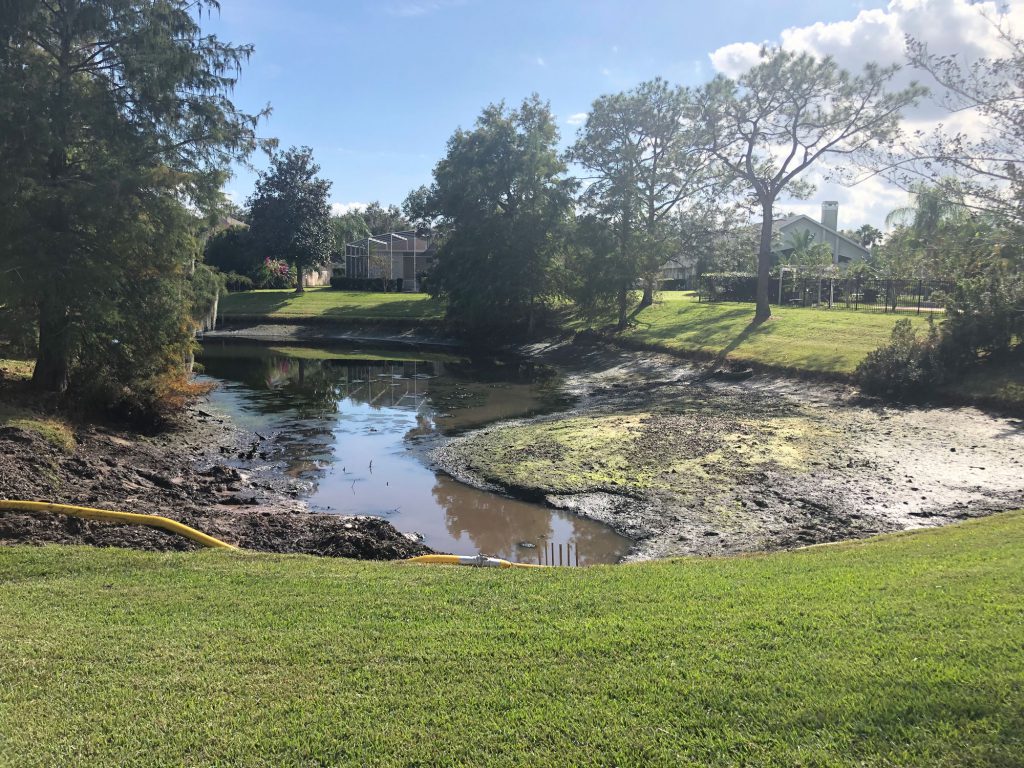
How to Know When It’s Time For Muck Removal
- Flooding – If your pond seems more shallow and no longer holds water as designed, even during light rainstorms
- Muck accumulation – Bottom muck often develops when eroded sediment, dead plant matter, and other debris do not decompose properly. Persistent muck accumulation is a strong sign of excessive build-up that requires physical removal.
- Chronic water quality problems – Persistent algae blooms and nuisance aquatic weeds suggest nutrient-rich bottom muck is causing significant imbalances in the ecosystem.
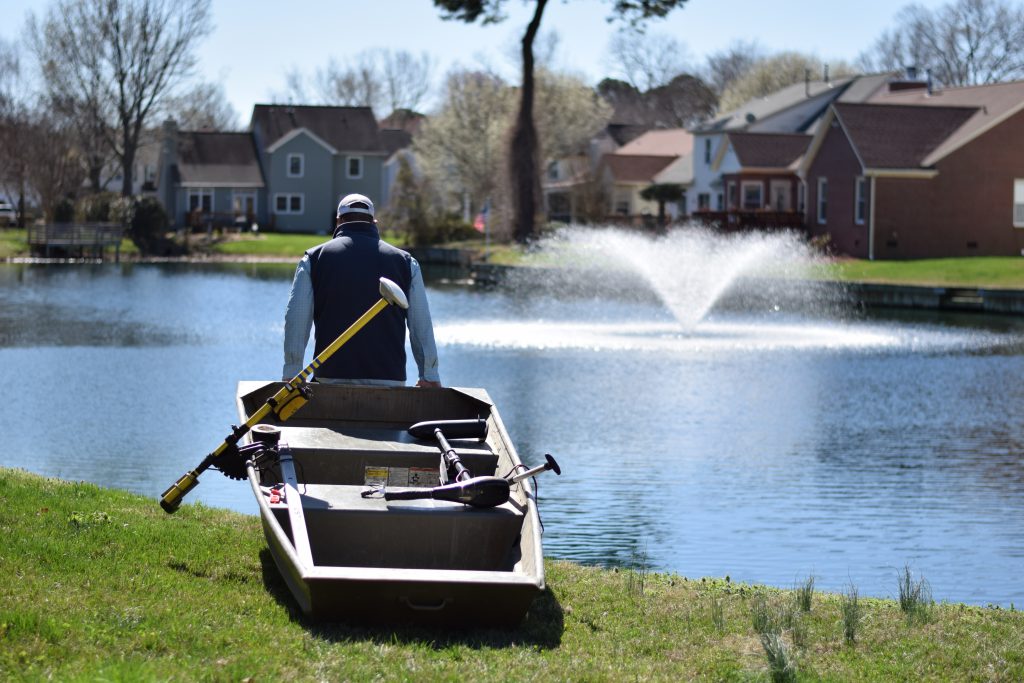
How to Prolong Stormwater Pond Depth and Volume
Every waterbody will require dredging at some point; in urban areas, approximately every 10-20 years. Unfortunately, it’s also one of the most expensive services an HOA, golf course, or private landowner may face. Because it can take decades to properly budget for, it’s important to implement proactive strategies that help delay and predict future dredging needs.
- Bathymetry – Conduct bathymetric mapping annually to monitor changes in bottom sediment buildup over time. These studies provide a clearer picture of when dredging may become necessary.
- Hydro-raking – Similar to a floating barge with a backhoe, a hydro-rake can remove organic muck and debris in target areas, such as near storm drains or pipes. This can help prolong the need for dredging.
- Beneficial bacteria – Apply bacteria to help the bottom muck decompose naturally. This is sometimes referred to as “biological dredging.”
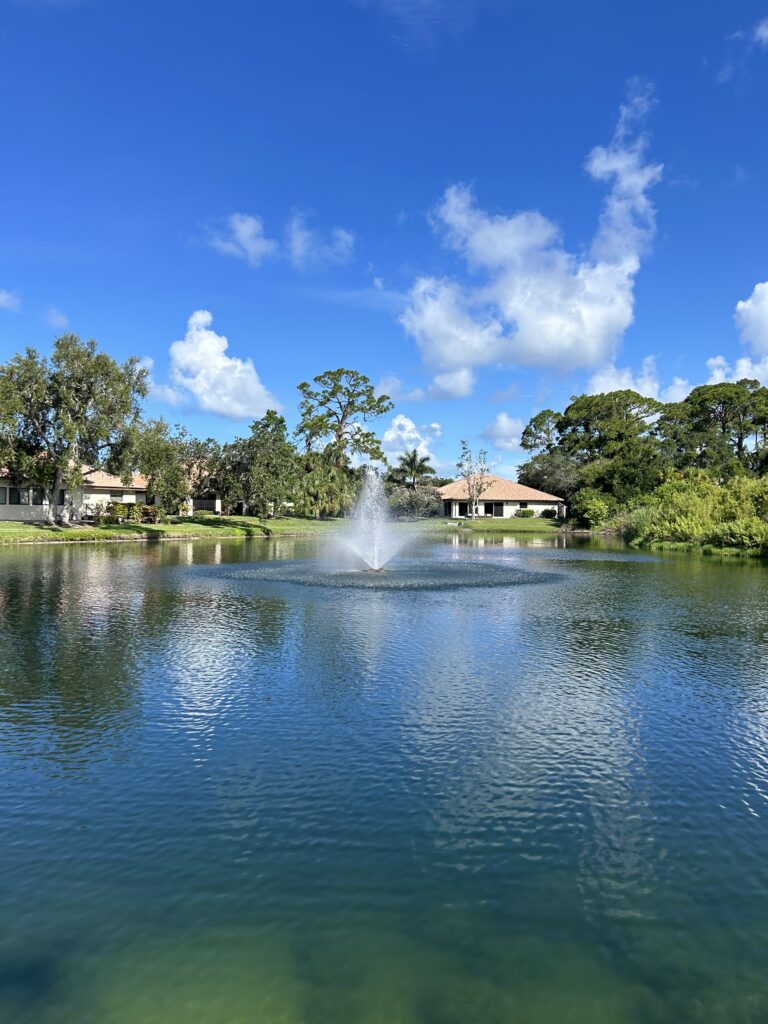
Maintain a healthy stormwater pond with proactive maintenance
Like a home or car, lakes and ponds need regular maintenance and inspections to function as intended. Fortunately, caring for your waterbody doesn’t have to be complicated. With support from a professional, you can ensure repairs and upgrades are effectively planned for, and feel confident that your pond is being managed with long-term savings and sustainability in mind.
Achieve Clean, Healthy Water with SOLitude
SOLitude Lake Management is a nationwide environmental firm committed to providing sustainable solutions that improve water quality, enhance beauty and preserve natural resources.
SOLitude’s team of aquatic scientists specializes in the development and execution of customized lake, stormwater pond, wetland and fisheries management programs. Services include water quality testing and restoration, algae and aquatic weed control, installation and maintenance of fountains and aeration systems, shoreline erosion control, muck and sediment removal and invasive species management. SOLitude partners with homeowners associations, golf courses, private landowners, businesses and municipalities. SOLitude Lake Management is part of Rentokil, a leading business services company, operating across the United States, Canada and Puerto Rico.
For more information, visit SOLitude Lake Management at solitudelakemanagement.com, and connect on Facebook, LinkedIn, Twitter, Instagram and YouTube.

